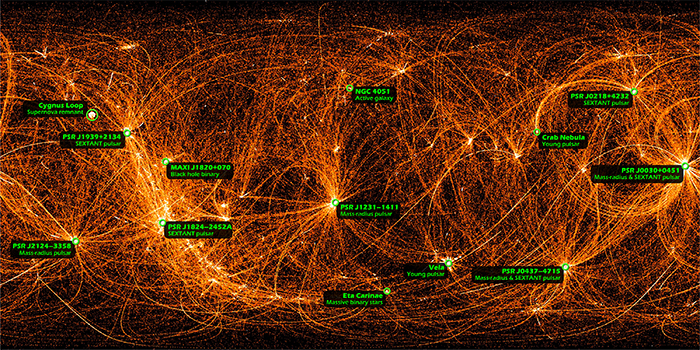Key Takeaways:
- NASA’s Neutron star Interior Composition Explorer (NICER) captures a mesmerizing X-ray snapshot of the night sky, revealing cosmic wonders.
- The image showcases sparkling dots and intricate patterns, representing two years of research on X-ray emissions from space.
- NICER, stationed on the International Space Station, employs the X-ray Timing Instrument to collect high-energy photons from various celestial sources.
- The brightness of certain spots signifies both NICER’s focus duration and their intense X-ray radiation, with a focus on enigmatic neutron stars.
- The mission aims to determine neutron star sizes with unprecedented precision, shedding light on their internal physics.
In a breathtaking display of cosmic fireworks, NASA’s Neutron star Interior Composition Explorer (NICER) has presented an awe-inspiring X-ray image of the night sky. This spectacular snapshot, obtained over nearly two years of dedicated effort, unveils a celestial tapestry of sparkling dots and intricate loops. From the vantage point of Earth’s orbit, NICER has cast a radiant spotlight on the enigmatic sources of X-rays, offering a perspective that challenges even the sleepless nights of Superman.

At the heart of this cosmic revelation lies the X-ray Timing Instrument, a cube roughly the size of a washing machine, nestled aboard the International Space Station (ISS). With precision rivaling an artisan’s brushstroke, this instrument meticulously collects high-energy photons from up to eight distinct locations per orbit. Each graceful curve etched in the image traces the instrument’s balletic movements as it shifts its attention from one celestial source to the next, while smaller flecks and lines bear witness to energetic particles colliding with the sensors.
Yet, it is the luminous ‘sparkles’ that steal the show. Their brilliance is a testament to NICER’s unwavering focus on these spots, which in turn emanate a profusion of X-ray radiation. Many of these luminous locales are the abode of neutron stars, celestial remnants so dense that they skirt the precipice of collapsing into black holes, bound only by a fundamental principle governing their nuclei.
However, the exact dimensions of these neutron stars remain a cosmic conundrum. Understanding their precise radius holds the promise of unraveling the mind-boggling physics transpiring within their cores. NICER’s mission endeavors to determine their size with an astonishing precision of just 5 percent, offering a key to unlock their secrets.
Among these celestial denizens, some are rapid-spinning pulsars. Pinning down the timing of each sweep of their lighthouse-like X-ray beams bestows astronomers with a meticulously detailed set of coordinates, akin to uncovering a cosmic treasure map.
Looking ahead, an enhanced version of NICER, known as the Station Explorer for X-ray Timing and Navigation Technology (SEXTANT) experiment, stands poised to gather data that not only promises to guide the future of the mission but also holds the potential to shape the course of space exploration itself.
As principal investigator Keith Gendreau from NASA’s Goddard Space Flight Center astutely notes, “Even with minimal processing, this image reveals the Cygnus Loop, a supernova remnant about 90 light-years across and thought to be 5,000 to 8,000 years old.” With each nightly sweep, NICER unveils the secrets of the cosmos, potentially unearthing previously unknown cosmic marvels. So, even if the intricacies of astrophysics don’t seize your imagination, this image invites you to envision yourself as an astronomer with X-ray vision, casually stargazing on Krypton.



